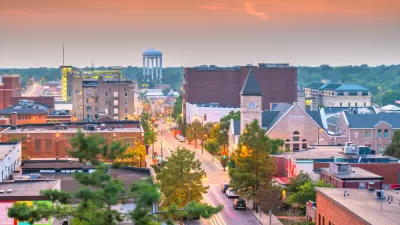A recent study documents the shift from large-scale units of production to smaller mass-produced units that can be dispersed across many locations. This shift promises to change a host of industries, from transportation to power generation.
A recent study out of Columbia University looks at the forces driving "a radical shift from building big to building small-a change that has
profound implications for both established and emerging industries...This trend-observable in nascent form in several industries ranging
from small, modular nuclear reactors, chlorine plants, and biomass
energy systems to data centers-is resulting in a switch from large to
small optimal unit scale, the authors found."
So what does this mean for land use and infrastructure planning and design? Here's one example from the energy industry cited in the study's press release: "Rather than relying on custom–built, large–scale units of production -
e.g. massive thermal power plants - industries can benefit from a shift
to small, modular, mass–produced units that can be deployed in a
single location or distributed across many locations - e.g.
photovoltaic (PV) panels mounted on utility poles." Single-use zoning for industry could soon become a thing of the past.
FULL STORY: Building Small: In Many Industries, Economies of Size Is Shifting to Economies of Numbers

Maui's Vacation Rental Debate Turns Ugly
Verbal attacks, misinformation campaigns and fistfights plague a high-stakes debate to convert thousands of vacation rentals into long-term housing.

Planetizen Federal Action Tracker
A weekly monitor of how Trump’s orders and actions are impacting planners and planning in America.

In Urban Planning, AI Prompting Could be the New Design Thinking
Creativity has long been key to great urban design. What if we see AI as our new creative partner?

King County Supportive Housing Program Offers Hope for Unhoused Residents
The county is taking a ‘Housing First’ approach that prioritizes getting people into housing, then offering wraparound supportive services.

Researchers Use AI to Get Clearer Picture of US Housing
Analysts are using artificial intelligence to supercharge their research by allowing them to comb through data faster. Though these AI tools can be error prone, they save time and housing researchers are optimistic about the future.

Making Shared Micromobility More Inclusive
Cities and shared mobility system operators can do more to include people with disabilities in planning and operations, per a new report.
Urban Design for Planners 1: Software Tools
This six-course series explores essential urban design concepts using open source software and equips planners with the tools they need to participate fully in the urban design process.
Planning for Universal Design
Learn the tools for implementing Universal Design in planning regulations.
planning NEXT
Appalachian Highlands Housing Partners
Mpact (founded as Rail~Volution)
City of Camden Redevelopment Agency
City of Astoria
City of Portland
City of Laramie





























